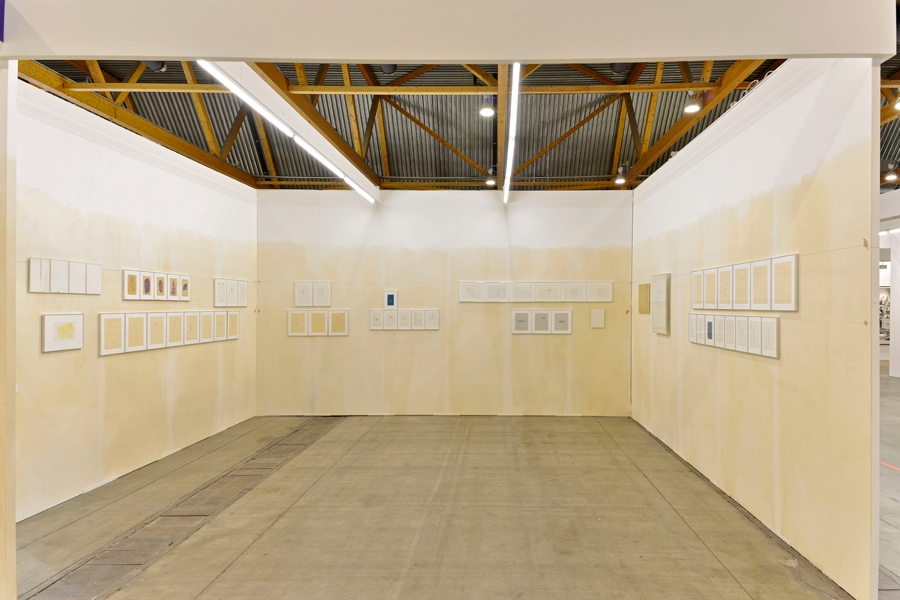With the flourishing of top tier art fairs in recent years, events like Art Brussels now see themselves fighting to assert their identity and significance on a busy schedule involving increasingly stressed gallerists, who are forced to cut out their presence at certain fairs. But with booths at the blue chip end of the market stacked with works from the same artists, fairs such as Artissima, MiArt and Art Brussels can offer something alternative, and are a good place to discover new artists. Art Brussels has always had a strong attendance by collectors, and many from outside Belgium visit over the weekend, rather than at the opening. All in all in this edition the booths were pleasant, the aisles were wide, and the atmosphere was a calm one, making it possible to spend more with more unfamiliar artists. Here are the top five booths that caught Art Review’s eye.
Joëlle Tuerlinckx at Galerie nächst St. Stephan Rosemarie Schwarzwälder, Vienna
This beautiful solo booth by Brussels-based artist Joëlle Tuerlinckx stood out a mile, due to the fact that the artist herself had transformed the space into an installation. Staining the booth walls unevenly with tea created an impression of fragility, as did the retention of the lines of coloured string used to mark the straight lines along which the works were hung – mostly small, minimal works on paper that were highly sculptural due to the warping and rippling of wet material applied to the paper. Tuerlinckx constantly cannibalises her own work, transforming it from exhibition to exhibition. She included sculptures here that originated from her exhibition WOR(LD)K IN PROGRESS, which opened at Wiels last year. These had been created by cutting out shaped sections of the temporary walls at Wiels, on which she had scrawled the titles of works, a piece still, seemingly, in progress.
Rochelle Feinstein at On Stellar Rays, New York
It was good to see some paintings by Rochelle Feinstein at On Stellar Rays’s booth, following her joint exhibition with this gallery and Higher Pictures in 2011. Feinstein’s paintings here acted like disrupted Abstract Expressionist works, playfully upset by material that encroached on their abstract qualities. A painting made up of a square of canvas painted white and Velcroed on to another, reportedly concealed hidden matter in the spaces between the two canvases, while another employed a squishy, wonky shattered grid through which one could peer through to other skewed grids, one of which disarmingly resembled a black and white tiled floor.
‘The Naked Truth’ at Sorry We’re Closed, Brussels
Things may have moved on since the heyday of feminist artist activists Guerrilla Girls but there was a sense of ‘plus ça change, plus c’est la même chose’ at Art Brussels when it came to the amount of female nudes on display. Architecturally, Art Brussels is split into two halls, roughly divided into a more blue chip half, and an edgier half including ‘Young Talent’ for younger galleries and ‘First Call’ for first time participants. On the more established side, the proliferation of female nudity in artworks, whole or partial, was highly noticeable. The reassertion of the corporeal in an incorporeal moment? Or playing to a somewhat sleazy, age-old appeal?. Thomas Ruff’s stripper photographs, Robert Mapplethorpe’s nudes, pretty young models in Slater Bradley and Ryan McGinley works. Sorry We’re Closed was at least even-handed about it, however, and devoted their booth to nudity of both sexes. The presence of some Spencer Tunick’s didn’t stop this being an enjoyable display, which paired Mapplethorpe’s photograph Lady Lisa Lyon (1982) with Barry Flanagan’s bronze sculpture Lisa Lyon (1982), and where a beautiful Pierre Klossowski work in watercolour and pencil was hung near Sean Landers’s video Remissionem Peccatorum (1994), in which the artist strips off slowly to opera, before beating himself with his own belt.
Supports/Surfaces group at Galerie Bernard Ceysson, Paris
Galerie Bernard Ceysson took an art historical stance. For some time they have been focussing on a group of artists who worked under the name Supports/Surfaces and who were active in Paris in the 1960s and 70s. This group created deconstructed forms of painting, propping up canvases with planks or hanging strips of painted fabric from walls as though they were decorative hangings. In the work of Daniel Dezeuze, for example, multicoloured, irregularly shaped canvases with holes cut out of the middle of them hung free from support frames, allowing them to appear fetishistic and symbolic. There were several revelatory works on this stand, which appeared extremely fresh – employing aesthetics that were broken, irregular and undone, while still reminding of the tie-dye and new age objects associated with the age in which they were made.
Sam Falls at M+B, LA
Sticking with softly hanging fabrics, but jumping a couple of generations, we lastly turn to the work of a younger artist, Sam Falls, whose minimal solo stand at M+B was comprised of monochrome fabric works in pastel, mid-tone shades such as pink, turquoise and violet. To create these Falls left large rectangles of coloured fabrics in the Topanga sunshine for extended periods of time, with pieces of looped garden hose attached to them. This resulted in soft sun drawings of squiggly curls on the hanging material, affecting a continuation of the locale’s ‘light and space’ movement, albeit with a distinct suburban inflection.
